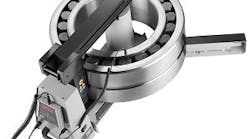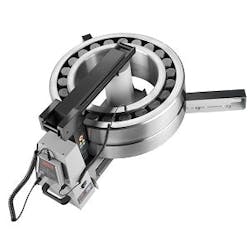Rolling bearings as precision components play vital roles in rotating machinery by helping to reduce friction, transmit loads, and locate and support shafts. Thousands of bearing types and styles offer a wide range of solutions suitable for applications in plants across industries. By understanding and implementing fundamental maintenance practices, optimized outcomes for bearings can follow.
Here are some back-to-basics maintenance tips to promote enhanced bearing performance and extended service life. All these basic tips can help advance a bearing’s performance, reliability, economy, and service life and, in the process, reduce maintenance time, labor, and costs.
Properly store all bearings. Bearings should always be stored in a cool, clean, low-humidity environment free of dust, shocks, and vibrations.
Tips for success in storage:
- Bearings should be flat rather than on end and be kept in their original, unopened packages until just before mounting. If kept in a standing position, the likelihood of false brinelling (marking of the raceways and rolling elements caused by residual vibration) increases significantly.
- In the cases of sealed or shielded types of bearings, operators should be cautious when storing them over long periods of time. The lubricating properties of the grease used to fill these types of bearings may deteriorate, causing potential lubricant-related problems when a system is up and running. Most bearing manufacturers have specific shelf-life limits, based upon the greases used in their bearings.
- Cleanliness is critical. All bearings should be kept clean because contamination and corrosion will shorten the life of any bearing.
Follow proper mounting procedures. When a bearing is mounted improperly — without using the appropriate techniques and tools — performance will almost certainly suffer and service life will be jeopardized. An estimated 16% of all premature bearing failures can be directly attributed to poor fitting, usually due to brute force installation, and incorrect fitting tools.
Either a too-loose fit or an extremely tight fit for a bearing can become problematic. An excessively loose fit will allow relative movement between mating components, resulting in fretting, smearing, scoring, wear, excessive heat, or fracture. Conversely, an extra-tight fit will reduce the bearing’s internal clearance, which in most cases will increase the operating temperature of the bearing in service.
Tips for success in mounting:
- When a bearing is ready to be mounted, maintenance staff should confirm that shaft and housing are clean, undamaged, and dimensionally accurate, with proper fit and tolerance; lubricant is clean and correctly specified; necessary tools and equipment are on hand; and safety precautions are in place.
- Whenever mounting a bearing, its rings, cages, and rolling elements or seals should never receive direct blows and the mounting force must never be directed through the rolling elements (Figure 1).
Figure 1. A fitting tool can be used for mounting of bearings to minimize risk of damage. This consists of sleeve, impact ring, and dead-blow hammer enabling effective transmission of mounting force.
- Select the proper mounting method for the job. The primary methods for proper mounting of a bearing are commonly referenced as “cold” or “hot,” consistent with their enabling technologies. Cold mounting, or mechanical mounting, generally is recommended for small- and medium-sized bearings, with outside diameters up to 4 in.; methods involving heat mounting will be appropriate for relatively larger bearings; and hydraulic techniques should be considered when mounting especially large bearings. Tools have been developed to accommodate each particular method (Figure 2).
Figure 2. Use an induction heater for pre-heating bearings before mounting to allow for expansion and easier installation.
Select the suitable lubricant. This will help bearings perform as long as intended. Good lubricants primarily provide a separating film between a bearing’s rolling elements, raceways, and cages to prevent metal-to-metal contact and undesired friction that otherwise would generate excessive heat that could cause wear, metal fatigue, and potential fusing of the bearing contact surfaces. The proper lubricant further acts to inhibit wear and corrosion and help guard against contamination damage.
Grease has traditionally served as the preferred lubricant for rolling bearings. The practical benefits become apparent: Grease is easy to apply, can be retained within a bearing’s housing, and offers protective sealing capabilities.
Tips for success in lubricant selection:
- Choose the correct type of grease to deliver the necessary base oil viscosity in the proper amount at the prevailing operating temperature. Half of all bearing failures attributed to poor lubrication are caused by selection of an inadequate grease type for the operating conditions or to mixing incompatible greases with different properties.
- By varying the oil viscosities, soap, and additives, distinct characteristics can be achieved to suit particular applications and operating conditions.
Deliver lubricant properly. The ultimate goal is to deliver the right lubricant in the right amount at the right time.
Tips for success with lubrication delivery:
- Employ automatic lubricators as more practical and effective alternatives to manual application. Manual lubrication with a grease gun typically can present major challenges for maintenance technicians if the appropriate tools, practices, and knowledge are absent, and reliability can further be affected by under- or over-greasing. In contrast, automatic lubrication is engineered to provide quantities of clean lubricant on a regular basis, while increasing safety and saving time for maintenance staff. Ready-to-use or tailored systems can be engaged, depending on application, lubricating points, and similar considerations.
- Keep an eye on how the lubricant is performing over time. The lubricant in a bearing arrangement gradually will lose its lubricating properties due to mechanical work, aging, or the buildup of contamination.
- Replenish or renew grease at regular intervals to help maximize bearing service life.
Properly dismount a bearing. One reason for dismounting an “old” bearing is to replace it with a new one. Another reason is for maintenance or replacement of other machine components.
Tips for success in dismounting:
- Proper methods and tools should be used, as is the case with the mounting procedure, especially if the bearing will be placed back into service. The choice of tools will depend on bearing type, size, and fit.
- Care must be taken not to damage the shaft, which can result in compromising a machine's efficiency. A damaged shaft can greatly influence the service life of the new bearing.



